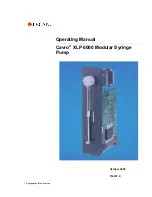
1 - 4
Cavro® XLP 6000 Modular Syringe Pump Operating Manual, 734237-C, en
1 - Getting Started
Functional Description of the XLP 6000
1.4.1
Syringe and Syringe Drive
The syringe plunger is moved within the syringe barrel by a lead screw drive that
incorporates a 1.8
°
stepper motor and quadrature encoder to detect lost steps.
The syringe drive has a 60 mm travel length and resolution of 6,000 increments
(48,000 increments in fine-positioning and microstep mode). When power is not
applied to the pump, the syringe drive can be removed by releasing the pin
assembly.
The base of the syringe plunger is held to the drive by a knurled screw. The top of
the syringe barrel attaches to the pump valve by a 1/4-28" fitting.
Figure 1-2, ’Syringe Components” shows the components of a typical syringe.
Figure 1-2
Syringe Components
Syringes are available in these sizes: 50
µ
L, 100
µ
L, 250
µ
L, 500
µ
L, 1.0 mL,
2.5 mL, 5.0 mL, 10 mL, and 25 mL.. For ordering information, see Appendix A,
"Ordering Information".
Note: To obtain optimal performance and maximum life from any syringe, please
follow the syringe cleaning and maintenance procedure included with each Cavro
Syringe. Technical Note #1 (PN 730317) contains practical tips for the use and
maintenance of Cavro Syringes.
1.4.2
Valve and Valve Drive
The valve is made of a Kel-F body and Teflon plug. The plug rotates inside the
valve body to connect the syringe port to the various input and output ports. In
addition to input and output ports, non-distribution valves also have a bypass
position. This position “bypasses” the syringe and connects the input and output
ports. The bypass position is often used for flushing fluid lines. The valve is turned
by a 1.8
°
stepper motor that has an encoder coupled to it for positioning feedback.















































